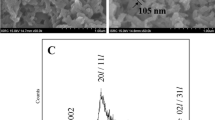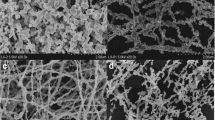Abstract
Carbon nanofibers (CNF) are efficient electrode modifiers in electrochemical biosensors that enhance the electrochemical active area, induce electrocatalytic effect toward the oxidation of the enzymatic cofactor nicotinamide adenine dinucleotide (reduced form, NADH), and enable the quantitative immobilization of enzymes. Combining CNF with efficient and stable mediators radically augments the speed of electron transfer between NADH and solid electrodes and leads to electrochemical sensors characterized by high sensitivity and stability. The main aim of this work was to investigate the performance of a novel mediator for NADH with advantageously low solubility in an electrochemical detector based on a screen-printed CNF electrode as well as its potential in biosensing. Using a mediator, prepared from Meldola Blue and Ni hexamine chloride, a stable and sensitive electrochemical NADH sensor is provided with a detection limit of 0.5 μmol L−1. Further on, covalent immobilization of a recently described aldehyde dehydrogenase from the Antarctic Flavobacterium PL002 strain on the surface of the mediator-modified electrode produced a stable biosensor for the detection of aldehydes. When integrated in a flow injection analysis (FIA) setup with amperometric detection at 0.1 V vs. Ag/AgCl, the measurement of benzaldehyde with a detection limit of 10 μmol L−1 over a linear range of 30–300 μmol L−1 is possible. Determination of trace benzaldehyde impurities in a pharmaceutical excipient was also demonstrated and results compared with a chromatographic method.

Graphical abstract





Similar content being viewed by others
References
Fanjul-Bolado P, Queipo P, Lamas-Ardisana PJ, Costa-García A (2007) Manufacture and evaluation of carbon nanotube modified screen-printed electrodes as electrochemical tools. Talanta 74(3):427–433. https://doi.org/10.1016/j.talanta.2007.07.035
Huang J, Liu Y, You T (2010) Carbon nanofiber based electrochemical biosensors: a review. Anal Methods 2(3):202–211. https://doi.org/10.1039/B9AY00312F
Wang Z, Wu S, Wang J, Yu A, Wei G (2019) Carbon nanofiber-based functional nanomaterials for sensor applications. Nanomaterials (Basel, Switzerland) 9(7). https://doi.org/10.3390/nano9071045
Titoiu AM, Lapauw M, Necula-Petrareanu G, Purcarea C, Fanjul-Bolado P, Marty J-L, Vasilescu A (2018) Carbon nanofiber and Meldola Blue based electrochemical sensor for NADH: application to the detection of benzaldehyde. Electroanalysis 30(11):2676–2688. https://doi.org/10.1002/elan.201800472
Arvinte A, Sesay Adama M, Virtanen V, Bala C (2008) Evaluation of Meldola Blue-carbon nanotube-sol-gel composite for electrochemical NADH sensors and their application for lactate dehydrogenase-based biosensors. Electroanalysis 20(21):2355–2362. https://doi.org/10.1002/elan.200804332
Jiang X, Zhu L, Yang D, Mao X, Wu Y (2009) Amperometric ethanol biosensor based on integration of alcohol dehydrogenase with Meldola’s Blue/ordered mesoporous carbon electrode. Electroanalysis 21(14):1617–1623. https://doi.org/10.1002/elan.200804586
Gorton L, Domínguez E (2002) Electrocatalytic oxidation of NAD(P)/H at mediator-modified electrodes. Rev Mol Biotechnol 82(4):371–392. https://doi.org/10.1016/S1389-0352(01)00053-8
Santhiago M, Strauss M, Pereira MP, Chagas AS, Bufon CCB (2017) Direct drawing method of graphite onto paper for high-performance flexible electrochemical sensors. ACS Appl Mater Interfaces 9(13):11959–11966. https://doi.org/10.1021/acsami.6b15646
Munteanu FD, Kubota LT, Gorton L (2001) Effect of pH on the catalytic electrooxidation of NADH using different two-electron mediators immobilised on zirconium phosphate. J Electroanal Chem 509(1):2–10. https://doi.org/10.1016/S0022-0728(01)00376-X
Sprules SD, Hart JP, Wring SA, Pittson R (1994) Development of a disposable amperometric sensor for reduced nicotinamide adenine dinucleotide based on a chemically modified screen-printed carbon electrode. Analyst 119(2):253–257. https://doi.org/10.1039/AN9941900253
Taniguchi I, Shimoota T, Tominaga M, Nishiyama K (1994) Potential-dependent rectified electron transfer at a Meldola’s Blue incorporated decanethiol-modified electrode as a model of biological membrane. Microchem J 49(2):340–354. https://doi.org/10.1006/mchj.1994.1045
Doaga R, McCormac T, Dempsey E (2009) Electrochemical sensing of NADH and glutamate based on Meldola Blue in 1,2-diaminobenzene and 3,4-ethylenedioxythiophene polymer films. Electroanalysis 21(19):2099–2108. https://doi.org/10.1002/elan.200904627
Schuhmann W, Huber J, Wohlschläger H, Strehlitz B, Gründig B (1993) Electrocatalytic oxidation of NADH at mediator-modified electrode surfaces. J Biotechnol 27(2):129–142. https://doi.org/10.1016/0168-1656(93)90103-T
Kumar SA, Chen SM (2007) Fabrication and characterization of Meldola’s Blue/zinc oxide hybrid electrodes for efficient detection of the reduced form of nicotinamide adenine dinucleotide at low potential. Anal Chim Acta 592(1):36–44. https://doi.org/10.1016/j.aca.2007.04.022
Vasilescu A, Andreescu S, Bala C, Litescu SC, Noguer T, Marty J-L (2003) Screen-printed electrodes with electropolymerized Meldola Blue as versatile detectors in biosensors. Biosens Bioelectron 18(5):781–790. https://doi.org/10.1016/S0956-5663(03)00044-7
Ghica ME, Pauliukaite R, Marchand N, Devic E, Brett CM (2007) An improved biosensor for acetaldehyde determination using a bienzymatic strategy at poly(neutral red) modified carbon film electrodes. Anal Chim Acta 591(1):80–86. https://doi.org/10.1016/j.aca.2007.03.047
Mitsubayashi K, Nishio G, Sawai M, Kazawa E, Yoshida H, Saito T, Kudo H, Otsuka K, Takao M, Saito H (2008) A biochemical sniffer-chip for convenient analysis of gaseous formaldehyde from timber materials. Microchim Acta 160(4):427–433. https://doi.org/10.1007/s00604-007-0799-7
Badalyan A, Neumann-Schaal M, Leimkühler S, Wollenberger U (2013) A biosensor for aromatic aldehydes comprising the mediator dependent PaoABC-aldehyde oxidoreductase. Electroanalysis 25(1):101–108. https://doi.org/10.1002/elan.201200362
European Council, European Directorate for the Quality of Medicines and Healthcare (2019) Benzyl alcohol monograph. European Pharmacopoeia 94:5327–5327
Necula-Petrareanu G, Lavin P, Vasilescu A, Purcarea C (2018) Antarctic Flavobacterium aldehyde dehydrogenase – a cold-adapted catalyst for biosensing. J Biotechnol 280:S18. https://doi.org/10.1016/j.jbiotec.2018.06.054
King HJS, Cruse AW, Angell FG (1932) 448. Researches on ammines. Part VI. Nickelammine salts in aqueous solution. Journal of the Chemical Society (Resumed) (0):2928-2931. https://doi.org/10.1039/JR9320002928
Mažeikienė R, Niaura G, Eicher-Lorka O, Malinauskas A (2011) Raman spectroelectrochemical study of Meldola Blue, adsorbed and electropolymerized at a gold electrode. J Colloid Interface Sci 357(1):189–197. https://doi.org/10.1016/j.jcis.2011.01.086
Hassan KM, Hathoot AA, Ashour WFD, Abdel-Azzem M (2015) Electrochemical and analytical applications for NADH detection at glassy carbon electrode modified with nickel nanoparticles dispersed on poly 1,5-diaminonaphthalene. J Solid State Electrochem 19(4):1063–1072. https://doi.org/10.1007/s10008-014-2705-7
Hou L, Bi S, Lan B, Zhao H, Zhu L, Xu Y, Lu Y (2019) A novel and ultrasensitive nonenzymatic glucose sensor based on pulsed laser scribed carbon paper decorated with nanoporous nickel network. Anal Chim Acta 1082:165–175. https://doi.org/10.1016/j.aca.2019.07.056
Avramescu A, Noguer T, Avramescu M, Marty J-L (2002) Screen-printed biosensors for the control of wine quality based on lactate and acetaldehyde determination. Anal Chim Acta 458(1):203–213. https://doi.org/10.1016/S0003-2670(01)01580-X
Radoi A, Compagnone D, Batic M, Klincar J, Gorton L, Palleschi G (2007) NADH screen-printed electrodes modified with zirconium phosphate, Meldola blue, and Reinecke salt. Application to the detection of glycerol by FIA. Anal Bioanal Chem 387(3):1049–1058. https://doi.org/10.1007/s00216-006-0975-3
Bilgi M, Sahin EM, Ayranci E (2018) Sensor and biosensor application of a new redox mediator: rosmarinic acid modified screen-printed carbon electrode for electrochemical determination of NADH and ethanol. J Electroanal Chem 813:67–74. https://doi.org/10.1016/j.jelechem.2018.02.012
Pariente F, Lorenzo E, Tobalina F, Abruna HD (1995) Aldehyde biosensor based on the determination of NADH enzymically generated by aldehyde dehydrogenase. Anal Chem 67(21):3936–3944. https://doi.org/10.1021/ac00117a019
Noguer T, Marty JL (1997) Reagentless sensors for acetaldehyde. Anal Lett 30(6):1069–1080. https://doi.org/10.1080/00032719708004039
Li Y, Liu X, Wu Q, Yi J, Zhang G (2018) Discrimination and detection of benzaldehyde derivatives using sensor array based on fluorescent carbon nanodots. Sensors Actuators B Chem 261:271–278. https://doi.org/10.1016/j.snb.2018.01.160
Nguyen HH, Lee SH, Lee UJ, Fermin CD, Kim M (2019) Immobilized enzymes in biosensor applications. Materials (Basel, Switzerland) 12(1). https://doi.org/10.3390/ma12010121
Bradbury SL, Clark JF, Steinman CR, Jakoby WB (1975) Aldehyde dehydrogenase from baker’s yeast. Methods Enzymol 41:354–360. https://doi.org/10.1016/s0076-6879(75)41079-5
Subhan MA, Chandra SP, Sumon S, Ahmed J, Asiri AM, Rahman M, Al-Mamun M (2018) Enhanced photocatalytic activity and ultra-sensitive benzaldehyde sensing performances of SnO2•ZnO•TiO2 nanomaterials. RSC Adv 8:33048–33058. https://doi.org/10.1039/C8RA05182H
Premaratne G, Farias S, Krishnan S (2017) Pyrenyl carbon nanostructures for ultrasensitive measurements of formaldehyde in urine. Anal Chim Acta 970:23–29. https://doi.org/10.1016/j.aca.2017.03.032
Shirasu N, Onodera T, Nagatomo K, Shimohigashi Y, Toko K, Matsumoto K (2009) Noncompetitive immunodetection of benzaldehyde by open sandwich ELISA. Anal Sci 25(9):1095–1100. https://doi.org/10.2116/analsci.25.1095
Onodera T, Shimizu T, Miura N, Matsumoto K, Toko K (2010) Surface plasmon resonance based sensitive immunosensor for benzaldehyde detection. IEEJ Transactions on Sensors and Micromachines 130(7):269–274. https://doi.org/10.1541/ieejsmas.130.269
Acknowledgments
The authors wish to thank Medana Zamfir, Institute of Biology of the Romanian Academy, for the support with HPLC measurements.
Funding
This study was financially supported by the Romanian Executive Agency for Higher Education, Research, Development and Innovation (UEFISCDI), through PN-III-P2-2.1-PED-2016-0116 grant and ERANET-M-ENZ4IFACES contract 166/01.05.2020 for Ana Maria Titoiu, Georgiana Necula-Petrareanu, Cristina Purcarea and Alina Vasilescu.
Author information
Authors and Affiliations
Corresponding author
Ethics declarations
Conflict of interest
The authors declare that they have no competing interests.
Additional information
Publisher’s note
Springer Nature remains neutral with regard to jurisdictional claims in published maps and institutional affiliations.
Electronic supplementary material
ESM 1
(DOCX 1.11 mb)
Rights and permissions
About this article
Cite this article
Titoiu, A.M., Necula-Petrareanu, G., Visinescu, D. et al. Flow injection enzymatic biosensor for aldehydes based on a Meldola Blue-Ni complex electrochemical mediator. Microchim Acta 187, 550 (2020). https://doi.org/10.1007/s00604-020-04477-3
Received:
Accepted:
Published:
DOI: https://doi.org/10.1007/s00604-020-04477-3




